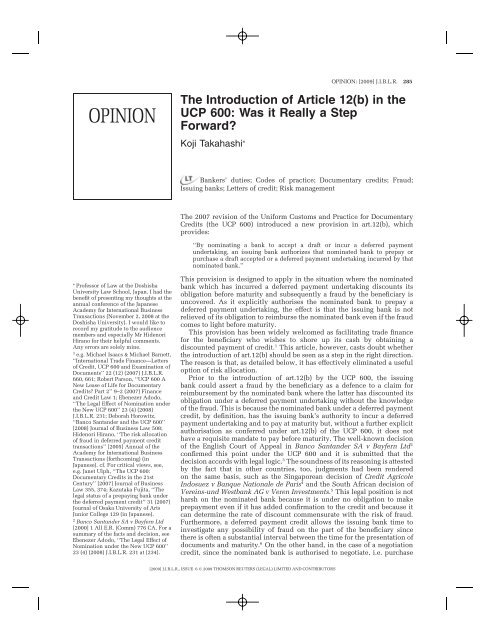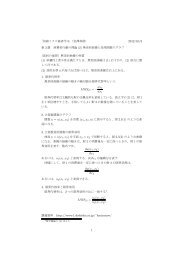The Introduction of Article 12(b) in the UCP 600
The Introduction of Article 12(b) in the UCP 600
The Introduction of Article 12(b) in the UCP 600
You also want an ePaper? Increase the reach of your titles
YUMPU automatically turns print PDFs into web optimized ePapers that Google loves.
OPINION: [2009] J.I.B.L.R. 285OPINION<strong>The</strong> <strong>Introduction</strong> <strong>of</strong> <strong>Article</strong> <strong>12</strong>(b) <strong>in</strong> <strong>the</strong><strong>UCP</strong> <strong>600</strong>: Was it Really a StepForward?Koji Takahashi ∗Bankers’ duties; Codes <strong>of</strong> practice; Documentary credits; Fraud;Issu<strong>in</strong>g banks; Letters <strong>of</strong> credit; Risk management<strong>The</strong> 2007 revision <strong>of</strong> <strong>the</strong> Uniform Customs and Practice for DocumentaryCredits (<strong>the</strong> <strong>UCP</strong> <strong>600</strong>) <strong>in</strong>troduced a new provision <strong>in</strong> art.<strong>12</strong>(b), whichprovides:‘‘By nom<strong>in</strong>at<strong>in</strong>g a bank to accept a draft or <strong>in</strong>cur a deferred paymentundertak<strong>in</strong>g, an issu<strong>in</strong>g bank authorizes that nom<strong>in</strong>ated bank to prepay orpurchase a draft accepted or a deferred payment undertak<strong>in</strong>g <strong>in</strong>curred by thatnom<strong>in</strong>ated bank.’’∗ Pr<strong>of</strong>essor <strong>of</strong> Law at <strong>the</strong> DoshishaUniversity Law School, Japan. I had <strong>the</strong>benefit <strong>of</strong> present<strong>in</strong>g my thoughts at <strong>the</strong>annual conference <strong>of</strong> <strong>the</strong> JapaneseAcademy for International Bus<strong>in</strong>essTransactions (November 2, 2008 at <strong>the</strong>Doshisha University). I would like torecord my gratitude to <strong>the</strong> audiencemembers and especially Mr HidenoriHirano for <strong>the</strong>ir helpful comments.Any errors are solely m<strong>in</strong>e.1 e.g. Michael Isaacs & Michael Barnett,‘‘International Trade F<strong>in</strong>ance—Letters<strong>of</strong> Credit, <strong>UCP</strong> <strong>600</strong> and Exam<strong>in</strong>ation <strong>of</strong>Documents’’ 22 (<strong>12</strong>) (2007) J.I.B.L.R.660, 661; Robert Parson, ‘‘<strong>UCP</strong> <strong>600</strong> ANew Lease <strong>of</strong> Life for DocumentaryCredits? Part 2’’ 9–2 (2007) F<strong>in</strong>anceand Credit Law 1; Ebenezer Adodo,‘‘<strong>The</strong> Legal Effect <strong>of</strong> Nom<strong>in</strong>ation under<strong>the</strong> New <strong>UCP</strong> <strong>600</strong>’’ 23 (4) (2008)J.I.B.L.R. 231; Deborah Horowitz,‘‘Banco Santander and <strong>the</strong> <strong>UCP</strong> <strong>600</strong>’’[2008] Journal <strong>of</strong> Bus<strong>in</strong>ess Law 508;Hidenori Hirano, ‘‘<strong>The</strong> risk allocation<strong>of</strong> fraud <strong>in</strong> deferred payment credittransactions’’ [2005] Annual <strong>of</strong> <strong>the</strong>Academy for International Bus<strong>in</strong>essTransactions (forthcom<strong>in</strong>g) (<strong>in</strong>Japanese). cf. For critical views, see,e.g. Janet Ulph, ‘‘<strong>The</strong> <strong>UCP</strong> <strong>600</strong>:Documentary Credits <strong>in</strong> <strong>the</strong> 21stCentury’’ [2007] Journal <strong>of</strong> Bus<strong>in</strong>essLaw 355, 374; Kazutaka Fujita, ‘‘<strong>The</strong>legal status <strong>of</strong> a prepay<strong>in</strong>g bank under<strong>the</strong> deferred payment credit’’ 31 (2007)Journal <strong>of</strong> Osaka University <strong>of</strong> ArtsJunior College <strong>12</strong>9 (<strong>in</strong> Japanese).2 Banco Santander SA v Bayfern Ltd[2000] 1 All E.R. (Comm) 776 CA. For asummary <strong>of</strong> <strong>the</strong> facts and decision, seeEbenezer Adodo, ‘‘<strong>The</strong> Legal Effect <strong>of</strong>Nom<strong>in</strong>ation under <strong>the</strong> New <strong>UCP</strong> <strong>600</strong>’’23 (4) (2008) J.I.B.L.R. 231 at [234].This provision is designed to apply <strong>in</strong> <strong>the</strong> situation where <strong>the</strong> nom<strong>in</strong>atedbank which has <strong>in</strong>curred a deferred payment undertak<strong>in</strong>g discounts itsobligation before maturity and subsequently a fraud by <strong>the</strong> beneficiary isuncovered. As it explicitly authorises <strong>the</strong> nom<strong>in</strong>ated bank to prepay adeferred payment undertak<strong>in</strong>g, <strong>the</strong> effect is that <strong>the</strong> issu<strong>in</strong>g bank is notrelieved <strong>of</strong> its obligation to reimburse <strong>the</strong> nom<strong>in</strong>ated bank even if <strong>the</strong> fraudcomes to light before maturity.This provision has been widely welcomed as facilitat<strong>in</strong>g trade f<strong>in</strong>ancefor <strong>the</strong> beneficiary who wishes to shore up its cash by obta<strong>in</strong><strong>in</strong>g adiscounted payment <strong>of</strong> credit. 1 This article, however, casts doubt whe<strong>the</strong>r<strong>the</strong> <strong>in</strong>troduction <strong>of</strong> art.<strong>12</strong>(b) should be seen as a step <strong>in</strong> <strong>the</strong> right direction.<strong>The</strong> reason is that, as detailed below, it has effectively elim<strong>in</strong>ated a usefuloption <strong>of</strong> risk allocation.Prior to <strong>the</strong> <strong>in</strong>troduction <strong>of</strong> art.<strong>12</strong>(b) by <strong>the</strong> <strong>UCP</strong> <strong>600</strong>, <strong>the</strong> issu<strong>in</strong>gbank could assert a fraud by <strong>the</strong> beneficiary as a defence to a claim forreimbursement by <strong>the</strong> nom<strong>in</strong>ated bank where <strong>the</strong> latter has discounted itsobligation under a deferred payment undertak<strong>in</strong>g without <strong>the</strong> knowledge<strong>of</strong> <strong>the</strong> fraud. This is because <strong>the</strong> nom<strong>in</strong>ated bank under a deferred paymentcredit, by def<strong>in</strong>ition, has <strong>the</strong> issu<strong>in</strong>g bank’s authority to <strong>in</strong>cur a deferredpayment undertak<strong>in</strong>g and to pay at maturity but, without a fur<strong>the</strong>r explicitauthorisation as conferred under art.<strong>12</strong>(b) <strong>of</strong> <strong>the</strong> <strong>UCP</strong> <strong>600</strong>, it does nothave a requisite mandate to pay before maturity. <strong>The</strong> well-known decision<strong>of</strong> <strong>the</strong> English Court <strong>of</strong> Appeal <strong>in</strong> Banco Santander SA v Bayfern Ltd 2confirmed this po<strong>in</strong>t under <strong>the</strong> <strong>UCP</strong> <strong>600</strong> and it is submitted that <strong>the</strong>decision accords with legal logic. 3 <strong>The</strong> soundness <strong>of</strong> its reason<strong>in</strong>g is attestedby <strong>the</strong> fact that <strong>in</strong> o<strong>the</strong>r countries, too, judgments had been renderedon <strong>the</strong> same basis, such as <strong>the</strong> S<strong>in</strong>gaporean decision <strong>of</strong> Credit AgricoleIndosuez v Banque Nationale de Paris 4 and <strong>the</strong> South African decision <strong>of</strong>Vere<strong>in</strong>s-und Westbank AG v Veren Investments. 5 This legal position is notharsh on <strong>the</strong> nom<strong>in</strong>ated bank because it is under no obligation to makeprepayment even if it has added confirmation to <strong>the</strong> credit and because itcan determ<strong>in</strong>e <strong>the</strong> rate <strong>of</strong> discount commensurate with <strong>the</strong> risk <strong>of</strong> fraud.Fur<strong>the</strong>rmore, a deferred payment credit allows <strong>the</strong> issu<strong>in</strong>g bank time to<strong>in</strong>vestigate any possibility <strong>of</strong> fraud on <strong>the</strong> part <strong>of</strong> <strong>the</strong> beneficiary s<strong>in</strong>ce<strong>the</strong>re is <strong>of</strong>ten a substantial <strong>in</strong>terval between <strong>the</strong> time for <strong>the</strong> presentation <strong>of</strong>documents and maturity. 6 On <strong>the</strong> o<strong>the</strong>r hand, <strong>in</strong> <strong>the</strong> case <strong>of</strong> a negotiationcredit, s<strong>in</strong>ce <strong>the</strong> nom<strong>in</strong>ated bank is authorised to negotiate, i.e. purchase[2009] J.I.B.L.R., ISSUE 6 © 2009 THOMSON REUTERS (LEGAL) LIMITED AND CONTRIBUTORS
motion for order to show cause that was served on you. Pr<strong>in</strong>t <strong>the</strong> name <strong>of</strong> <strong>the</strong>motion on <strong>the</strong> blank l<strong>in</strong>e. You do not need to check <strong>the</strong> box next to “hear<strong>in</strong>g requested.” A hear<strong>in</strong>g hasalready been scheduled. <strong>The</strong> date time and place <strong>of</strong> <strong>the</strong> hear<strong>in</strong>g are <strong>in</strong> <strong>the</strong>order to show cause. Paragraph (1): State <strong>the</strong> facts relevant to <strong>the</strong> motion that are with<strong>in</strong> <strong>the</strong> firsthandknowledge <strong>of</strong> <strong>the</strong> person sign<strong>in</strong>g <strong>the</strong> statement. This means <strong>the</strong> personmust have observed <strong>the</strong> facts personally, ra<strong>the</strong>r than be<strong>in</strong>g told about <strong>the</strong>facts. Paragraph (2): List and attach any documents you want to use to support <strong>the</strong>facts. Paragraph (3): You do not need to check <strong>the</strong> box next to “hear<strong>in</strong>g requested.”A hear<strong>in</strong>g has already been scheduled. <strong>The</strong> date time and place <strong>of</strong> <strong>the</strong>hear<strong>in</strong>g are <strong>in</strong> <strong>the</strong> order to show cause. Attach any required documents and forms. Date and sign <strong>the</strong> form. Complete <strong>the</strong> Certificate <strong>of</strong> Service. Serve <strong>the</strong> form and any attachments on <strong>the</strong> o<strong>the</strong>r party by one <strong>of</strong> <strong>the</strong> methodsdescribed <strong>in</strong> <strong>the</strong> certificate <strong>of</strong> service. URCP 5 governs service. File <strong>the</strong> orig<strong>in</strong>al form, attachments and certificate <strong>of</strong> service with <strong>the</strong> judicialservices representative.(2) Reply Statement (if applicable)If you file a Statement Oppos<strong>in</strong>g <strong>the</strong> Motion, <strong>the</strong> o<strong>the</strong>r party may file a Reply,but only to respond to someth<strong>in</strong>g be<strong>in</strong>g raised for <strong>the</strong> first time <strong>in</strong> youroppos<strong>in</strong>g statement. If <strong>the</strong> oppos<strong>in</strong>g statement and its support<strong>in</strong>g documentsmerely make statements <strong>of</strong> fact and legal arguments aga<strong>in</strong>st <strong>the</strong> po<strong>in</strong>ts made<strong>in</strong> <strong>the</strong> motion, <strong>the</strong>n <strong>the</strong> o<strong>the</strong>r party cannot file a Reply. <strong>The</strong> Reply must be filedand served at least 3 bus<strong>in</strong>ess days before <strong>the</strong> hear<strong>in</strong>g.(3) Attend <strong>the</strong> Hear<strong>in</strong>gAll motions decided by a commissioner will be decided after a hear<strong>in</strong>g, unless<strong>the</strong> parties agree to <strong>the</strong> motion.Be sure to attend <strong>the</strong> hear<strong>in</strong>g. If you fail to attend, a judgment may be enteredaga<strong>in</strong>st you and <strong>the</strong> commissioner or judge may f<strong>in</strong>d you <strong>in</strong> contempt <strong>of</strong> court.For more <strong>in</strong>formation, see our webpage on Go<strong>in</strong>g to Court.2014.04 2
OPINION: [2009] J.I.B.L.R. 28711 Requir<strong>in</strong>g <strong>the</strong> tender <strong>of</strong> certa<strong>in</strong>documents such as a quality certificateissued by a reputable <strong>in</strong>stitution wouldgo some way towards protect<strong>in</strong>g aga<strong>in</strong>stfrauds but is not a cure-all solution <strong>in</strong><strong>the</strong> face <strong>of</strong> a determ<strong>in</strong>ed fraudster.<strong>12</strong> See art.1(2) <strong>of</strong> <strong>the</strong> <strong>UCP</strong> <strong>600</strong>.13 Robert Parson, ‘‘<strong>UCP</strong> <strong>600</strong> A NewLease <strong>of</strong> Life for Documentary Credits?Part 1’’ 9–1 (2007) F<strong>in</strong>ance and CreditLaw 1, 3.14 In relation to Banco Santander SA vBayfern Ltd [2000] 1 All E.R. (Comm)776 CA, see Daniel Aharoni & AdamJohnson ‘‘Fraud and DiscountedDeferred Payment DocumentaryCredits: <strong>The</strong> Banco Santander’’ 15(2000) J.I.B.L.R. 22 at [25]; <strong>in</strong> relation toCredit Agricole Indosuez v BanqueNationale de Paris [2001] 2 S.L.R. 1,see Soh Chee Seng, ‘‘Deferred PaymentLCs Re-Visited’’ (May 2001)Documentary Credit World 29 (thoughdisapprov<strong>in</strong>g <strong>the</strong> decision itself).reflect <strong>the</strong> practice or to wait for <strong>the</strong> practice to be brought <strong>in</strong> l<strong>in</strong>e with<strong>the</strong> rules. As <strong>the</strong> full title <strong>of</strong> <strong>the</strong> <strong>UCP</strong>, ‘‘Uniform Customs and Practicefor Documentary Credits,’’ implies, it should usually be <strong>the</strong> rules whichshould be adjusted to <strong>the</strong> practice. However, <strong>in</strong> <strong>the</strong> present context, it mustbe doubted whe<strong>the</strong>r <strong>the</strong> <strong>in</strong>troduction <strong>of</strong> art.<strong>12</strong>(b) was a step <strong>in</strong> <strong>the</strong> rightdirection.[2009] J.I.B.L.R., ISSUE 6 © 2009 THOMSON REUTERS (LEGAL) LIMITED AND CONTRIBUTORS



